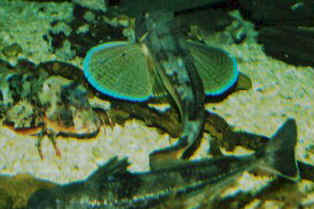Trigla lucerna - Tub Gurnard
Phylum: Chordata - Class: Actinopterygii - Order: Scorpaeniformes - Family: Triglidae

The largest of the gurnards found around the shores of Wales, the tub gurnard typically grows to between 1 and 4lb (0.5 to 2kg).
The relatively large pectoral fins make this a powerful fighter for its weight, and exceptional specimens can reach 10lb (4.5kg) and put up quite a scrap. The Welsh record rod-caught tub gurnard was caught from the shore at Langland Bay on the Gower Peninsula (South-west Wales); it weighed 12lb 3oz (approx. 5kg).
Unlike the grey gurnard, the tub gurnard is thought to be a relatively short-lived fish, perhaps attaining an age of six or eight years. It feeds on fish for the most part, and sand eels, small flat fish and poor cod usually feature highly in its diet. Tub gurnard will also feed well up in the water when there are plenty of small fish about, and they can sometimes be seen breaking the surface.

To catch tub gurnard, it is usually best to fish over a sandy bed or areas where rocks are interspersed with sandy stretches. Mackerel strips, mussels, ragworms, lugworms and crab are all effective baits.
Excited at the prospect of flyfishing? So are we, and we're pretty sure you would find the Winding River Mystery trilogy of action-packed thrillers gripping reading too. Dead Drift, Dead Cert, and Dead End are Pat O'Reilly's latest river-and-flyfishing based novels, and now they are available in ebook format. Full details on our website here...
Buy each book for just £4.96 on Amazon...
Please Help Us: If you have found this information interesting and useful, please consider helping to keep First Nature online by making a small donation towards the web hosting and internet costs.
Any donations over and above the essential running costs will help support the conservation work of Plantlife, the Rivers Trust and charitable botanic gardens - as do author royalties and publisher proceeds from books by Pat and Sue.
